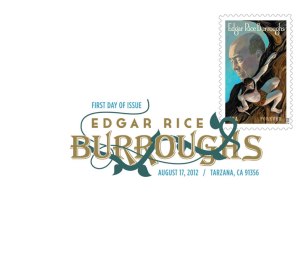“I have been writing for nineteen years and I have been successful probably because I have always realized that I knew nothing about writing, and have merely tried to tell an interesting story entertainingly.”
So wrote Edgar Rice Burroughs (1875–1950) in the June 1930 issue of Writer’s Digest. And entertain he did. By 1930, Burroughs had published more than 40 novels, 13 of them about his most iconic character—Tarzan. By the end of his life he had written more than 70 books, including historical fiction and several popular series of science fiction tales.
 Today we issue a new Forever® stamp in honor of Burroughs, one of the most popular and prolific writers of the early 20th century. (Forever stamps are always equal in value to the current First-Class Mail one-ounce rate.) The artwork for the stamp features Tarzan, his most iconic character, clinging to a vine, with a profile of Burroughs in the background. The depiction of Tarzan is an interpretation of the character by artist Sterling Hundley. To create the portrait of Burroughs, Hundley used a photograph taken by the author’s son, Hulbert Burroughs. The 1934 photograph shows Burroughs reading a hardcover copy of Tarzan and the Lion Man, which was published the same year.
Today we issue a new Forever® stamp in honor of Burroughs, one of the most popular and prolific writers of the early 20th century. (Forever stamps are always equal in value to the current First-Class Mail one-ounce rate.) The artwork for the stamp features Tarzan, his most iconic character, clinging to a vine, with a profile of Burroughs in the background. The depiction of Tarzan is an interpretation of the character by artist Sterling Hundley. To create the portrait of Burroughs, Hundley used a photograph taken by the author’s son, Hulbert Burroughs. The 1934 photograph shows Burroughs reading a hardcover copy of Tarzan and the Lion Man, which was published the same year.
The first Tarzan story, “Tarzan of the Apes,” was published in the October 1912 issue of All-Story magazine and issued as a book in 1914. “I do not say the story is true, for I did not witness the happenings which it portrays,” writes Burroughs in the first chapter, “but the fact that in the telling of it to you I have taken fictitious names for the principal characters quite sufficiently evidences the sincerity of my own belief that it may be true.”
And with that, America was hooked. Tarzan grew into a phenomenon that has transcended the printed word.
First Day Cover (click image to order)
In the years that followed, Burroughs’s Tarzan stories were published in magazines, syndicated in newspapers, and republished in more than 24 books. In 1918, the silent film Tarzan of the Apes became the first of more than 50 Tarzan movies. Tarzan was the subject of a comic strip beginning in 1929, radio series in the 1930s and the 1950s, and several television series in the 1970s, 1980s, and 1990s.
Burroughs also wrote prolifically beyond the Tarzan series. He published dozens of stories in pulp magazines such as Amazing Stories, Argosy All-Story, and Blue Book, resulting in eleven books about John Carter of Mars and six books in the Pellucidar series, which focused on a world at the center of the Earth—a world also visited by Tarzan in the 1930 book Tarzan at the Earth’s Core. He wrote novels about Apache warriors, samurai, prehistoric islands, and adventurers on the planet Venus, and, in an interesting departure, he also explored the modern world in The Girl From Hollywood, a 1922 novel about stardom, drug abuse, murder, and power.
The Edgar Rice Burroughs stamp was issued today at a ceremony in (where else?) Tarzana, California. Those who missed the celebration can still pick up a from the event.
Tarzan™ Owned by Edgar Rice Burroughs, Inc. and Used by Permission.
 Postmarked 2012 exhibits and then auctions off beautifully illustrated envelopes and letters from artists around the world. The proceeds benefit the Prison Library Project, which provides books and other educational material to prisons around the U.S. Submissions for this year’s auction will be accepted through the end of the month.
Postmarked 2012 exhibits and then auctions off beautifully illustrated envelopes and letters from artists around the world. The proceeds benefit the Prison Library Project, which provides books and other educational material to prisons around the U.S. Submissions for this year’s auction will be accepted through the end of the month.





